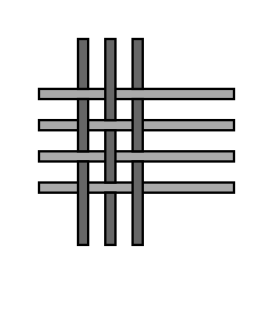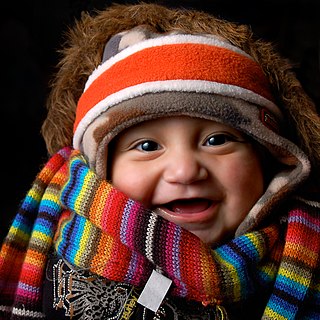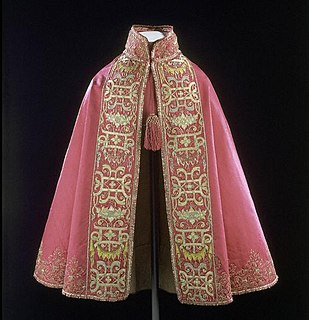Related Research Articles

Wool is the textile fibre obtained from sheep and other animals, including cashmere and mohair from goats, qiviut from muskoxen, hide and fur clothing from bison, angora from rabbits, and other types of wool from camelids.

A textile is a flexible material made by creating an interlocking bundle of yarns or threads, which are produced by spinning raw fibers into long and twisted lengths. Textiles are then formed by weaving, knitting, crocheting, knotting, tatting, felting, bonding, or braiding these yarns together.
Yarn is a long continuous length of interlocked fibres, suitable for use in the production of textiles, sewing, crocheting, knitting, weaving, embroidery, or ropemaking. Thread is a type of yarn intended for sewing by hand or machine. Modern manufactured sewing threads may be finished with wax or other lubricants to withstand the stresses involved in sewing. Embroidery threads are yarns specifically designed for needlework.

Linen is a textile made from the fibers of the flax plant.

Wool classing is the production of uniform, predictable, low-risk lines of wool, carried out by examining the characteristics of the wool in its raw state and classing (grading) it accordingly. Wool classing is done by a wool classer.

Metallic fibers are manufactured fibers composed of metal, metallic alloys, plastic-coated metal, metal-coated plastic, or a core completely covered by metal.

Plain weave is the most basic of three fundamental types of textile weaves. It is strong and hard-wearing, and is used for fashion and furnishing fabrics.
Olefin fiber is a synthetic fiber made from a polyolefin, such as polypropylene or polyethylene. It is used in wallpaper, carpeting, ropes, and vehicle interiors.

Textile fibers, threads, yarns and fabrics are measured in a multiplicity of units.
Staple refers to textile fibers of discrete length. The opposite is a filament fiber, which comes in continuous lengths. Staple length is a characteristic fiber length of a sample of staple fibers. It is an essential criterion in yarn spinning aids in cohesion and twisting. Compared to synthetic fibers, natural fibers tend to have different and shorter lengths. The quality of natural fibers like cotton is categorized on staple length such as short, medium, long-staple and, extra long. Gossypium barbadense, one of several cotton species, produces extra-long staple fibers. The staple fibers may be obtained from natural and synthetic sources. In the case of synthetics and blends, the filament yarns are cut to a predetermined length.

In textile manufacturing, finishing refers to the processes that convert the woven or knitted cloth into a usable material and more specifically to any process performed after dyeing the yarn or fabric to improve the look, performance, or "hand" (feel) of the finish textile or clothing. The precise meaning depends on context.

Uster Technologies, in its industry often called USTER, is a Swiss manufacturer of analytical instruments and on-line monitoring systems for the textile industry, based in Uster, Switzerland. It emerged as a management buy-out form of the Zellweger Luwa Group in 2003. From 2007 until 2012 the company was publicly traded and listed on the main segment of SIX Swiss Exchange. Since 2012 Uster Technologies is a subsidiary of Toyota Industries Corporation.

Cotton recycling prevents unneeded wastage and can be a more sustainable alternative to disposal. Recycled cotton can come from secondhand clothing or from textile waste or leftovers which are then spun into new yarns and fabrics. There are some notable limitations of recycled cotton, including separation of materials that are cotton/polyester mix. There may also be limits to durability in using recycled cotton.
Fabric inspection, also known as fabric checking, is a systematic fabric evaluation in which defects are identified. Fabric inspection takes place at various stages of manufacturing, including intermediate and final. "Perching" was another term for fabric inspection.

Cotton maturity is a physical testing parameter of cotton fiber properties testing. It is quantified by the degree of cell wall thickening relative to its perimeter. The maturity of individual cotton fiber is an essential aspect of the cotton classing regarding the aesthetics such as appearance, dye-uptake, etc. High volume instrument (HVI) can test cotton maturity like many other fiber properties, including length, uniformity, micronaire/fineness, strength, color, etc.

Hand feel is the property of fabrics related to the touch that expresses sensory comfort. It refers to the way fabrics feel against the skin or in the hand and conveys information about the cloth's softness and smoothness. Hand feel is an estimated and subjective property of different fabrics, but nowadays, hand feel could be measured and assessed statistically.
Yarn conditioning is fixing the amount of moisture in the yarns. It is possible by conditioning them in a humidified environment or with the help of a conditioning machine.
Singeing is a preparation method of textiles; it is applied more commonly to woven textiles and cotton yarns where a clean surface is essential. Singeing in textiles is a mechanical treatment or finish to obtain a neat surface of the fabric or less hairy yarn. In a singeing machine, the yarns or fabrics are exposed to direct flames or to the heated plates to burn the protruding fibers. Hence, also called "gassing."
A blend is an intimate mixture of two or more fibers. In yarn spinning, different compositions, lengths, diameters, or colors may be combined to create a blend. The term, blend, refers to spun fibers or a fabric composed of such fibers. There are several synonymous terms: a combination yarn is made up of two strands of different fibers twisted together to form a ply; a mixture or mixed cloth refers to blended cloths in which different types of yarns are used in warp and weft sides.

Aesthetics in textiles is one of the basic concepts of serviceability of textiles. It is determined by the perception of touch and sight. Aesthetics imply the appearance and attraction of textile products; it includes the color and texture of the material. It is a statement about the end user (consumer) and the target market. When combined with fabric construction, the finish of the clothing material, garment fit, style, and fashion compatibility, colours create an aesthetic comfort. All of these elements work together to satisfy our visual perception. Aesthetics incorporates the role of evaluation also.
References
- ↑ "History and Scope". USDA.
- 1 2 "US cotton standards". United Nations Conference on Trade and Development. Archived from the original on 2007-02-14. Retrieved 2009-12-10.
- 1 2 3 4 Kadolph, Sara J. (2007). Textiles. Internet Archive. Upper Saddle River, N.J. : Pearson Prentice Hall. pp. 45, 46. ISBN 978-0-13-118769-6.
- 1 2 "The Classification of Cotton". Cotton Inc. Retrieved 2022-02-09.
- ↑ Kadolph, Sara J. (1998). Textiles. Internet Archive. Upper Saddle River, N.J. : Merrill. pp. 38, 39. ISBN 978-0-13-494592-7.
- ↑ American-egyptian co. 1951. pp. 34, 35, 36.
- ↑ Service, United States Agricultural Research (1944). Research Achievement Sheet. p. 127.
- ↑ "The Classification of Cotton". 2011-01-14. Archived from the original on 2011-01-14. Retrieved 2021-01-14.